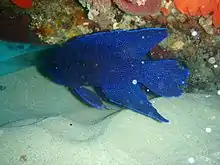Southern blue devil
The southern blue devil (Paraplesiops meleagris) is a species of fish in the longfin family Plesiopidae endemic to southern Australia. It is a close relative of the eastern blue devil (Paraplesiops bleekeri), which lives in the coastal waters of eastern Australia, and of the western blue devil (P. sinclairi), of southwestern Western Australia with which it is sometimes considered conspecific.
| Southern blue devil | |
|---|---|
 | |
| Scientific classification | |
| Kingdom: | Animalia |
| Phylum: | Chordata |
| Class: | Actinopterygii |
| Family: | Plesiopidae |
| Genus: | Paraplesiops |
| Species: | Paraplesiops meleagris |
| Binomial name | |
| Paraplesiops meleagris (Peters, 1869) | |
| Synonyms | |
| |
Description
The fish grows to about 350 mm in length. It is generally deep blue, bluish, or blue-brown in colour with a scattering of brighter blue spots, with a long dorsal and large anal and pelvic fins.[1]
Distribution and habitat
These fish are found along the southern Australian coastline, from South Australia to eastern Victoria. They occupy reefs, ledges, crevices, and deep cave systems, at depths ranging from 3 to over 40 m, sometimes in small groups containing individuals of sizes varying from small juveniles to mature adults.[1]
Behaviour
Breeding
Eggs are laid on a substrate and are guarded by the male until they hatch.[1]
Feeding
They feed on fish and crustaceans.[1]
References
- "Southern Blue Devil". Animal species. Australian Museum. Retrieved 2012-02-10.